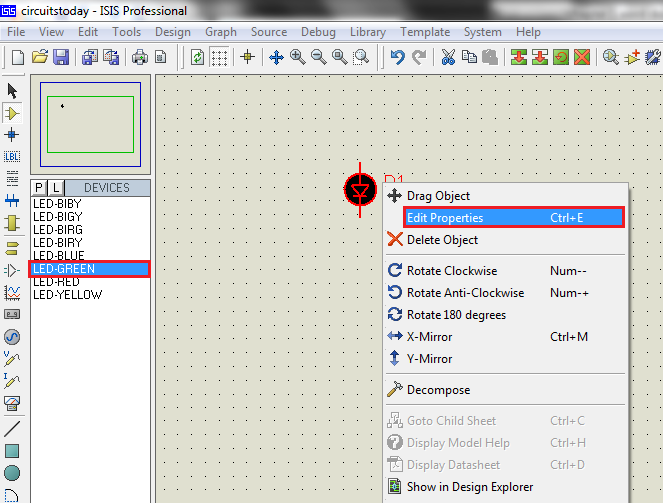Summary of Proteus Tutorial – Light Emitting Diode (LED) and Bar Graph Display
This article explains how to use Light Emitting Diode (LED) components in Proteus simulation software. It guides users in selecting LEDs from the Optoelectronics library with active properties for real-time simulation. The tutorial emphasizes the importance of series resistors to protect LEDs by calculating the resistor value using the formula Rs = (Vsource – LED voltage drop) / LED forward current. An example is given for a 2V LED at 20mA with a 5V supply, resulting in a 150Ω resistor. Instructions include selecting components and adjusting resistor values for accurate simulations.
Parts used in the Proteus LED Project:
- Light Emitting Diode (LED)
- Battery (Power Source)
- Resistor
How to work with Light Emitting Diode (LED) in Proteus
In this post we will be learning on how to use the “Light Emitting Diode (LED)” component in Proteus simulation software. In case you have not got on through the basics of Proteus, here is the link – Proteus PCB Design and Simulation Software – Introduction.
Note:- You may also read our 1st chapter on Proteus Tutorial Series – Switches and Relays in Proteus before you continue reading this chapter.
Types of LEDs available in Proteus
Proteus contains LEDs of different colors and types that are being used in real time applications.
LEDs are found in Proteus software under Library category Optoelectronics. Remember to select ‘ACTIVE’ components so that the simulator provides real time interface during simulation.
- Step 1: Select component mode.
- Step 2: Click on Pick devices ‘P’.
- Step 3: Scroll down categories to find ‘Optoelectronics’ or alternatively type LED in Keyword. Select
this category and it shows the available LEDs in the result. - Step 4: Scroll to find the required LEDs according to circuit.
- Step 5: Remember to select components with ACTIVE property under Library column of the search
results for interactive simulation.

Using LEDs in Circuits
LEDs must be powered with voltages under specified limits, so that safe current flows through it without damaging. It is better to use a series resistance to ensure it is under Safe Operating Area(SOA).Formula to calculate series resistance is
Rs = (Vsource–Voltage drop of LED)/(Maximum Forward Current)
Applying this formula to LED of 2 Volts drop and 20mA forward current for a source voltage of 5Volts, gives series resistance of 150 Ω.
Rs = (5-2)/0.02 = 150 Ω
Step 1: Select components required i.e.., Battery, LED and resistor. Resistor of required value may not be available, but choose any valued resistor and edit its resistance in Edit Properties Tab. Wattage of resistor need not to be considered while simulation until PCB layout is expected. In hardware implementations, it is to be chosen according to LED and source voltage.
For More Details : Proteus Tutorial – Light Emitting Diode (LED) and Bar Graph Display
